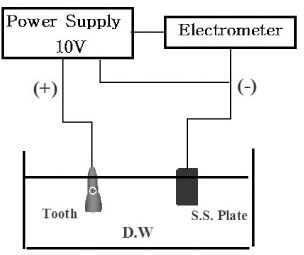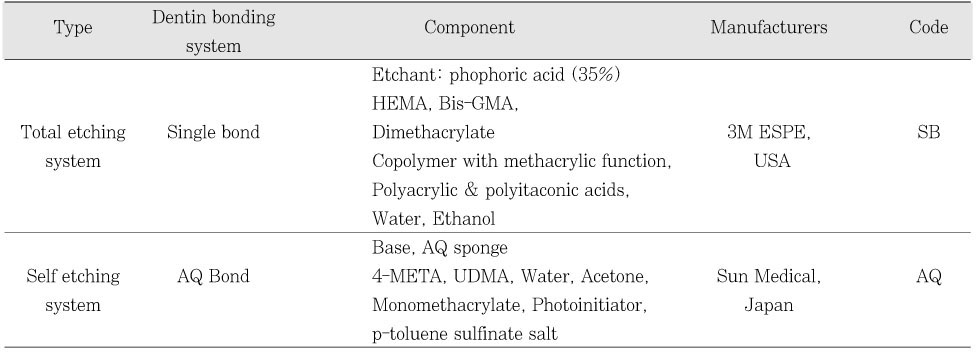Articles
- Page Path
- HOME > Restor Dent Endod > Volume 32(4); 2007 > Article
- Original Article Microleakage of composite resin restoration according to the number of thermocycling
- Chang-Youn Kim, Dong-Hoon Shin
-
2007;32(4):-384.
DOI: https://doi.org/10.5395/JKACD.2007.32.4.377
Published online: July 31, 2007
Department of Conservative Dentistry, College of Dentistry, Dankook University, Korea.
- Corresponding Author: Dong-Hoon Shin. Department of Conservative Dentistry, College of Dentistry, Dankook University, 7-1 Shinbu-dong, Cheonan, Chungnam, 330-716, Korea. Tel: 82-41-550-1965, Fax: 82-41-550-1963, donyshin@dankook.ac.kr
• Received: June 12, 2007 • Revised: June 27, 2007 • Accepted: June 28, 2007
Copyright © 2007 Korean Academy of Conservative Dentistry
- 849 Views
- 2 Download
- 3 Crossref
Abstract
-
Present tooth bonding system can be categorized into total etching bonding system (TE) and self-etching boding system (SE) based on their way of smear layer treatment. The purposes of this study were to compare the effectiveness between these two systems and to evaluate the effect of number of themocycling on microleakage of class V composite resin restorations.Total forty class V cavities were prepared on the single-rooted bovine teeth and were randomly divided into four experimental groups: two kinds of bonding system and another two kinds of thermocycling groups. Half of the cavities were filled with Z250 follwing the use of TE system, Single Bond and another twenty cavities were filled with Metafil and AQ Bond, SE system. All composite restoratives were cured using light curing unit (XL2500, 3M ESPE, St. Paul, MN, USA) for 40 seconds with a light intensity of 600 mW/cm2.Teeth were stored in distilled water for one day at room temperature and were finished and polished with Sof-Lex system. Half of teeth were thermocycled 500 times and the other half were thermocycled 5,000 times between 5℃ and 55℃ for 30 second at each temperature.Teeth were isolated with two layers of nail varnish except the restoration surface and 1 mm surrounding margins. Electrical conductivity (µA) was recorded in distilled water by electrochemical method. Microleakage scores were compared and analyzed using two-way ANOVA at 95% level.From this study, following results were obtained: There was no interaction between variables of bonding system and number of thermocycling (p = 0.485). Microleakage was not affected by the number of thermocycling either (p = 0.814). However, Composite restoration of Metafil and AQ Bond, SE bond system showed less microleakage than composite restoration of Z250 and Single Bond, TE bond system (p = 0.005).
- 1. Buonocore MG. A simple method of increasing the adhesion of acrylic filling materials to enamel surfaces. J Dent Res. 1955;34: 849-853.ArticlePubMedPDF
- 2. Mjör IA. Human coronal dentine: structure and reactions. Oral Surg Oral Med Oral Pathol. 1972;33: 810-823.ArticlePubMed
- 3. Gwinnett AJ, Jendresen MD. Micromorphological features of cervical erosion after acid conditioning and its relation with composite resin. J Dent Res. 1978;57: 543-549.PubMed
- 4. Fusayama T, Nakamura M, Kurosaki N, Iwaku M. Non-pressure adhesion of a new adhesive restorative resin. J Dent Res. 1979;58: 1364-1370.ArticlePubMedPDF
- 5. Shimada Y, Iwamoto N, Kawashima M, Burrow MF, Tagami J. Shear bond strength of current adhesive systems to enamel, dentin and dentin-enamel junction region. Oper Dent. 2003;28: 585-590.PubMed
- 6. Tay FR, Gwinnett AJ, Wei SH. The overwet phenomenon: an optical, micromorphological study of surface moisture in the acid-conditioned, resin-dentin interface. Am J Dent. 1996;9: 43-48.PubMed
- 7. Perdigão J, Van Meerbeek B, Lopes MM, Ambrose WW. The effect of a re-wetting agent on dentin bonding. Dent Mater. 1999;15: 282-295.ArticlePubMed
- 8. Frankenberger R, Sindel J, Krjämer N, Petschelt A. Dentin bond strength and marginal adaptation: Direct composite resins vs. ceramic inlays. Oper Dent. 1999;24: 147-155.PubMed
- 9. Swift EJ, Wilder AD, May KN, Waddell SL. Shear bond strengths of one-bottle dentin adhesives using multiple applications. Oper Dent. 1997;22: 194-199.PubMed
- 10. Brunton PA, Cowan AJ, Wilson MA, Wilson NH. A three-year evaluation of restorations placed with a smear layer-mediated dentin bonding agent in non-carious cervical lesions. J Adhes Dent. 1999;1: 333-341.PubMed
- 11. Spencer P, Wang Y, Walker MP, Wieliczka DM, Swafford JR. Interfacial chemistry of the dentin/adhesive bond. J Dent Res. 2000;79: 1458-1463.PubMed
- 12. Watanabe I, Nakabayashi N, Pashley DH. Bonding to ground dentin by a phenyl-P self-etching primer. J Dent Res. 1994;73: 1212-1220.ArticlePubMedPDF
- 13. Torii Y, Itou K, Nishitani Y, Ishikawa K, Suzuki K. Effect of phosphoric acid etching prior to self-etching primer application on adhesion of resin composite to enamel and dentin. Am J Dent. 2002;15: 305-308.PubMed
- 14. Erhardt MC, Cavalcante LM, Pimenta LA. Influence of Phosphoric Acid Pretreatment on Self-Etching Bond Strengths. J Esthet Restor Dent. 2004;16: 33-40.ArticlePubMed
- 15. Ernst CP. Positioning self-etching adhesives: versus or in addition to phosphoric acid etching? J Esthet Restor Dent. 2004;16: 57-69.PubMed
- 16. Brackett WW, Haisch LD, Pearce MG, Brackett MG. Microleakage of Class V resin composite restorations placed with self-etching adhesives. J Prosthet Dent. 2004;91: 42-45.ArticlePubMed
- 17. Fabianelli A, Kugel G, Ferrari M. Efficacy of self-etching primer on sealing margins of class II restorations. Am J Dent. 2003;16: 37-41.PubMed
- 18. Santini A, Plasschaert AJ, Mitchell S. Effect of composite resin placement techniques on the microleakage of two self-etching dentin-bonding agents. Am J Dent. 2001;14: 132-136.PubMed
- 19. Cardoso PE, Placido E, Francci CE, Perdigao J. Microleakage of class V resin-based composite restorations using five simplified adhesive systems. Am J Dent. 1999;12: 291-294.PubMed
- 20. Turkun SL. Clinical evaluation of a self-etching and a one-bottle adhesive system at two years. J Dent. 2003;31: 527-534.ArticlePubMed
- 21. Crim GA, Chapman KW. Reducing microleakage in class II restorations: an in vitro study. Quintessence Int. 1994;25: 781-785.PubMed
- 22. Iwami Y, Yamamoto H, Ebisu S. A new electrical method for detecting marginal leakage of in vitro resin restorations. J Dent. 2000;28: 241-247.ArticlePubMed
- 23. Mattison GD, von Fraunhofer JA. Electrochemical microleakage study of endodontic sealer/cements. Oral Surg Oral Med Oral Pathol. 1983;55: 402-407.PubMed
- 24. Iwami Y, Yamamoto H, Ebisu S. A new electrical method for detecting marginal leakage of in vitro resin restorations. J Dent. 2000;28: 241-247.ArticlePubMed
- 25. Nakano Y. A new electrical testing method on marginal leakage of composite resin restorations. Jpn J Conserv Dent. 1985;8: 1183-1198.
- 26. Delivanis PD, Chapman KA. Comparison and reliability of techniques for measuring leakage and marginal penetration. Oral Surg Oral Med Oral Pathol. 1982;53: 410-416.ArticlePubMed
- 27. Gueders AM, Charpentier JF, Albert AI, Geerts SO. Microleakage after thermocycling of 4 etch and rinse and 3 self-etch adhesives with and without a flowable composite lining. Oper Dent. 2006;31: 450-455.PubMed
- 28. Besnault C, Attal JP. Influence of a simulated oral environment on microleakage of two adhesive systems in Class II composite restorations. J Dent. 2002;30: 1-6.ArticlePubMed
- 29. Bedran-de-Castro AK, Cardoso PE, Ambrosano GM, Pimenta LA. Thermal and mechanical load cycling on microleakage and shear bond strength to dentin. Oper Dent. 2004;29: 42-48.PubMed
- 30. Aguiar FH, Dos Santos AJ, Franca FM, Paulillo LA, Lovadino JR. A quantitative method of measuring the microleakage of thermocycled or non-thermocycled posterior tooth restorations. Oper Dent. 2003;28: 793-789.PubMed
- 31. Pazinatto FB, Campos BB, Costa LC, Atta MT. Effect of the number of thermocycles on microleakage of resin composite restorations. Pesqui Odontol Bras. 2003;17: 337-341.PubMed
- 32. Koyuturk AE, Akca T, Yucel AC, Yesilyurt C. Effect of thermal cycling on microleakage of a fissure sealant polymerized with different light sources. Dent Mater J. 2006;25: 713-718.ArticlePubMed
- 33. Miyazaki M, Sato M, Onose H, Moore BK. Influence of thermal cycling on dentin bond strength of two-step bonding systems. Am J Dent. 1998;11: 118-122.PubMed
REFERENCES
Tables & Figures
REFERENCES
Citations
Citations to this article as recorded by 

- Evaluation of Shear Bond Strength and Microleakage of Bulk-fill Resin Composites
Hanbyeol Lee, Hyunwoo Seo, Juhyun Lee, Howon Park
THE JOURNAL OF THE KOREAN ACADEMY OF PEDTATRIC DENTISTRY.2015; 42(4): 281. CrossRef - Effect of Er:YAG lasing on the dentin bonding strength of two-step adhesives
Byeong-Choon Song, Young-Gon Cho, Myung-Seon Lee
Journal of Korean Academy of Conservative Dentistry.2011; 36(5): 409. CrossRef - Microleakage of the experimental composite resin with three component photoinitiator systems
Ji-Hoon Kim, Dong-Hoon Shin
Journal of Korean Academy of Conservative Dentistry.2009; 34(4): 333. CrossRef
Microleakage of composite resin restoration according to the number of thermocycling

Figure 1
Schematic drawing of electrochemical test.
Figure 1
Microleakage of composite resin restoration according to the number of thermocycling
Component of dentin bonding systems
Currents from electrochemical test (µA)
Different letters means statistically significant differences (p < 0.05)
Two-way ANOVA result
Currents between restoratives (µA)
Different letters means statistically significant differences (p < 0.05)
Table 1
Component of dentin bonding systems
Table 2
Currents from electrochemical test (µA)
Different letters means statistically significant differences (
Table 3
Two-way ANOVA result
Table 4
Currents between restoratives (µA)
Different letters means statistically significant differences (

 KACD
KACD





 ePub Link
ePub Link Cite
Cite

